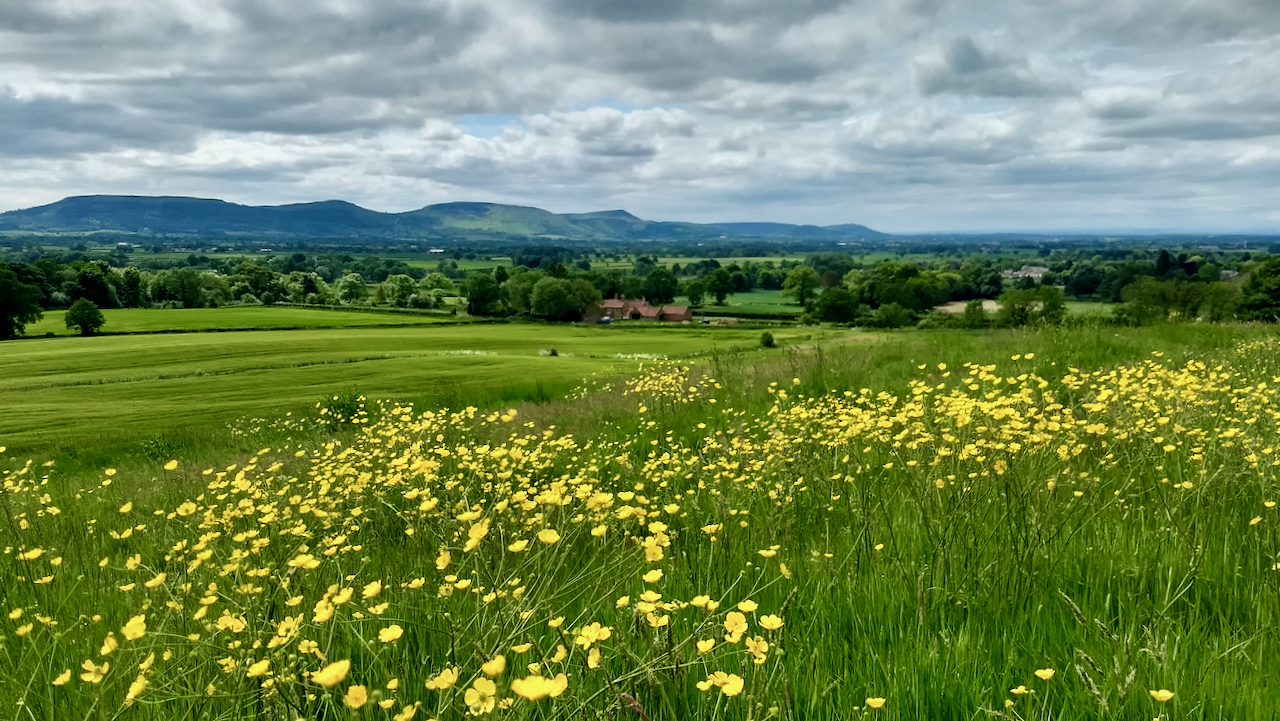Buttercup is another of those words excluded from the latest edition of the Oxford Junior Dictionary1Macfarlane, Robert. 2015. “The Word-Hoard: Robert Macfarlane on Rewilding Our Language of Landscape,” The Guardian (The Guardian) <https://www.theguardian.com/books/2015/feb/27/robert-macfarlane-word-hoard-rewilding-landscape> [accessed 10 June 2021]. They are giving a fine display this year. Whole fields are painted yellow yet in neighbouring fields there are none. It’s almost as if they’re a crop.
These are, I believe, Meadow buttercups (Ranunculus acris). These are an indicator of moist unimproved grassland, and thrive in old meadows and pastures. This display is on Rye Hill, an old reclaimed gravel quarry and rubbish tip, although I guess the quarry would not actually have extended this far up the hill. Sheep and cattle find Meadow Buttercups not palatable and it is not tolerant of high nutrient levels2North York Moors National Park. 2018. “A to Z: A Rabble of Rs,” The Official Blog for the North York Moors National Park (The official blog for the North York Moors National Park) <https://northyorkmoorsnationalpark.wordpress.com/2018/04/16/a-to-z-a-rabble-of-rs/> [accessed 10 June 2021].
In contrast the Creeping buttercup (Ranunculus repens) is very tolerant of high nutrient levels and is found on disturbed ground. Like the Meadow Buttercup, it usually has 5 petals but, because it spreads by creeping runners, mutations can occur giving it more petals. The frequency of these mutations can give an indication of the age of a patch3“Buttercups Reveal Age of Meadow – Aberystwyth University.” 2021. Aber.ac.uk <https://www.aber.ac.uk/en/news/archive/2009/june/title-77794-en.html> [accessed 10 June 2021].
The other common buttercup species is the Bulbous buttercup (Ranunculus bulbosus), which prefers much drier conditions.
All three species of buttercup can be found in fields that show evidence of medieval ploughing with the distinctive ridge and furrow profile. The Bulbous buttercup favouring the dry ridge; the Creeping buttercup the damper furrows; and on the flanks of the ridges is found the Meadow buttercup.
Local names for the Meadow buttercup include Blister-plant (Lincs.), Butter-bump/Butter-rose, Crazy-bet, Creesy-cressy (Glos.), Crow-flower, King’s-cob, and Gowan (Scot.)4“The English Dialect Dictionary, Being the Complete Vocabulary of All Dialect Words Still in Use, or Known to Have Been in Use during the Last Two Hundred Years; Founded on the Publications of the English Dialect Society and on a Large Amount of Material Never before Printed”. In six volumes edited by Joseph Wright, 1898. Internet Archive, 2014, archive.org/details/englishdialectdi03wriguoft/page/188/mode/2up. Accessed 10 Apr. 2021..
You may recognise this last Scottish word ‘gowans‘ from one of the verses of the Robbie Burns song ‘Auld Lang Syne‘:
We twa hae run about the braes,
And pou’d the gowans fine,
But we’ve wander’d monie a weary fitt,
Sin auld lang syne.
So next New Year, if we are allowed, you’ll be able to sing with more gusto.
- 1Macfarlane, Robert. 2015. “The Word-Hoard: Robert Macfarlane on Rewilding Our Language of Landscape,” The Guardian (The Guardian) <https://www.theguardian.com/books/2015/feb/27/robert-macfarlane-word-hoard-rewilding-landscape> [accessed 10 June 2021]
- 2North York Moors National Park. 2018. “A to Z: A Rabble of Rs,” The Official Blog for the North York Moors National Park (The official blog for the North York Moors National Park) <https://northyorkmoorsnationalpark.wordpress.com/2018/04/16/a-to-z-a-rabble-of-rs/> [accessed 10 June 2021]
- 3“Buttercups Reveal Age of Meadow – Aberystwyth University.” 2021. Aber.ac.uk <https://www.aber.ac.uk/en/news/archive/2009/june/title-77794-en.html> [accessed 10 June 2021]
- 4“The English Dialect Dictionary, Being the Complete Vocabulary of All Dialect Words Still in Use, or Known to Have Been in Use during the Last Two Hundred Years; Founded on the Publications of the English Dialect Society and on a Large Amount of Material Never before Printed”. In six volumes edited by Joseph Wright, 1898. Internet Archive, 2014, archive.org/details/englishdialectdi03wriguoft/page/188/mode/2up. Accessed 10 Apr. 2021.

Leave a Reply